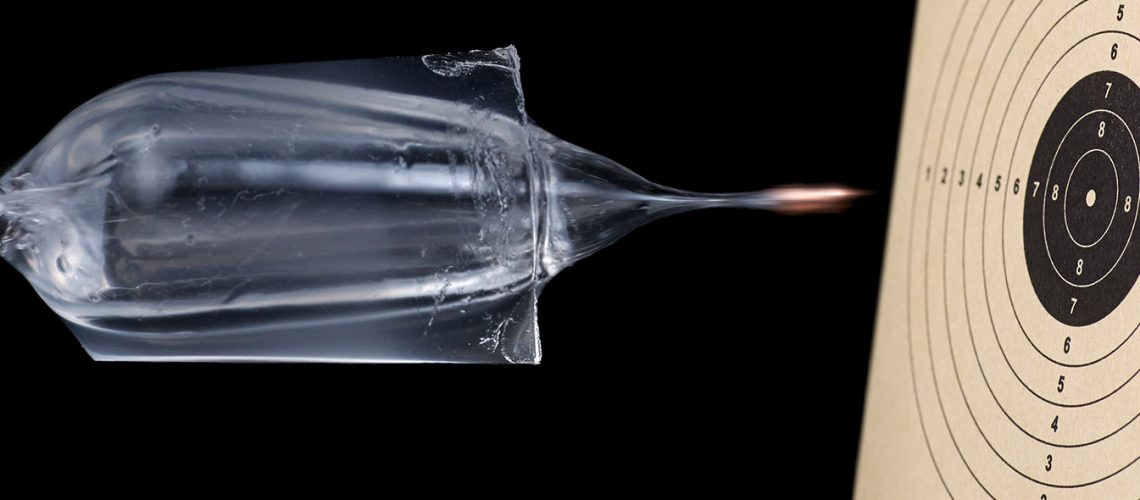JUST EXACTLY WHAT IS HYDROSTATIC SHOCK?
Hydrostatic shock is the principle that a penetrating projectile—like a bullet—produces a pressure wave (similar to a sound wave in air) resulting in remote neural damage, subtle damage in neural tissues, and perhaps rapid incapacitating effects in living targets.
 More simply, hydrostatic shock is the idea that the pressure wave caused by a bullet causes animal tissue to suffer injures beyond the wound created by the bullet only. Basically, hydrostatic shock stretches a temporary wound cavity causing a rip or distortion of animal tissues—and damages the central nervous system beyond the actual bullet wound.
More simply, hydrostatic shock is the idea that the pressure wave caused by a bullet causes animal tissue to suffer injures beyond the wound created by the bullet only. Basically, hydrostatic shock stretches a temporary wound cavity causing a rip or distortion of animal tissues—and damages the central nervous system beyond the actual bullet wound.
Even simpler? Wounds caused by the impact of a bullet result in neurological incapacitation beyond the actual wound channel.
And, now that you’re grasping what hydrostatic shock is, you’ll also have to grasp the notion that some people think hydrostatic shock exists, and some people don’t.
One of the earliest and most prominent advocates of hydrostatic shock was Colonel Frank Chamberlin, a World War II trauma surgeon and ballistics researcher. Colonel Chamberlin noted the “hydraulic reaction” in tissue struck by bullets, commenting, “…liquids are put in motion by ‘shock waves’ or hydraulic effects…with liquid filled tissues, the effects and destruction of tissues extend in all directions far beyond the wound axis.”

WHAT DO PROPONENTS SAY?
In addition to the Wound Data and Munitions Effectiveness Team data from Vietnam discussed below, advocates of hydrostatic shock point to human autopsy results in support of their position. That evidence supports the position that trauma exists well beyond that actual wound channel. For example, a gunshot striking the chest could have a damaging effect on the brain.
The pressure waves resulting from the impact of a hypersonic bullet can also travel well above the speed of sound. This means a drastic increase in pressure moves through the body quickly. Experiments have proven that blood pressure increases in organs far from the point of impact of a bullet—brain blood pressure increasing when shot in the thigh, for example.
In addition, experiments have also indicated that central nervous systems experience distant effects of high-energy projectiles due to ballistic pressure waves.
WHAT DO DETRACTORS SAY?
Vietnam-era surgeon Dr. Martin Fackler, head of the Wound Ballistics Laboratory for the U.S. Army’s Medical Training Center, believed that hydrostatic shock had been debunked by his studies, and that the role of pressure waves in trauma was mythical.
His views and subsequent scientific studies did gain support, but other data and analysis from the Wound Data and Munitions Effectiveness Team report on Vietnam tends to dispel his key assertions.
HYDROSTATIC SHOCK & AMMUNITION FOR SELF-DEFENSE AND LAW ENFORCEMENT
While some police departments and ballistic experts recognize the importance of hydrostatic shock, many consider hydrostatic shock insignificant, as the effects are not easily measured, and may differ from one individual to the next. They stress that proper shot placement and severity of wound channel are more important factors.
The FBI has a minimum penetration recommendation of 12 inches in ballistic gelatin, and does not recommend selecting ammunition based on hydrostatic shock effects.
HYDROSTATIC SHOCK & AMMUNITION FOR HUNTING
Although hydrostatic shock is a frequent consideration in hunting, it’s important to keep in mind the relationship between the size of round, kinetic energy applied, and the size of prey.
The larger the prey, the less effect hydrostatic shock may have due to the pressure wave’s incapacitating effects diminishing before having the desired effect.
 In a 2003 article by Jim Carmichael in Outdoor Life Magazine, Carmichael details how a Cape Buffalo culling effort resulted in some of the buffalo dropping where they were shot, while others did not—after having been hit in the lung-heart area. Subsequent investigation showed those buffalo that fell where they were shot had extensive rupturing of blood vessels in the brain.
In a 2003 article by Jim Carmichael in Outdoor Life Magazine, Carmichael details how a Cape Buffalo culling effort resulted in some of the buffalo dropping where they were shot, while others did not—after having been hit in the lung-heart area. Subsequent investigation showed those buffalo that fell where they were shot had extensive rupturing of blood vessels in the brain.
Conversely, those buffalo that didn’t fall where they were shot, didn’t have the extensive damage that would likely indicate damage from hydrostatic shock.
The North American Hunting club advocates big game cartridges with attributes to create the necessary hydrostatic shock in order to bring animals down.
The majority of evidence indicates that hydrostatic shock does, in fact, exist. The real issue is how much effect does it actually have? As much as the actual permanent wound and wound channel? Unlikely, but some say possible. A definitive and legitimate effect that’s useful and desirable? Certainly, depending on your application.
While the concept and the effects of hydrostatic shock are fascinating, to the vast majority of people interested in hunting or personal defense it becomes almost purely academic, and is never a priority over good shot placement and proper weapon handling.

